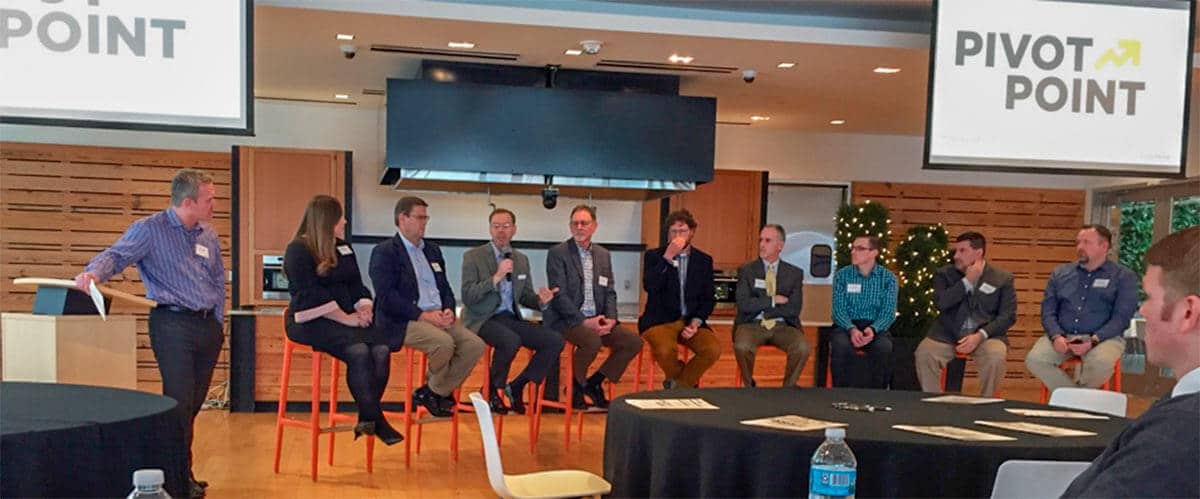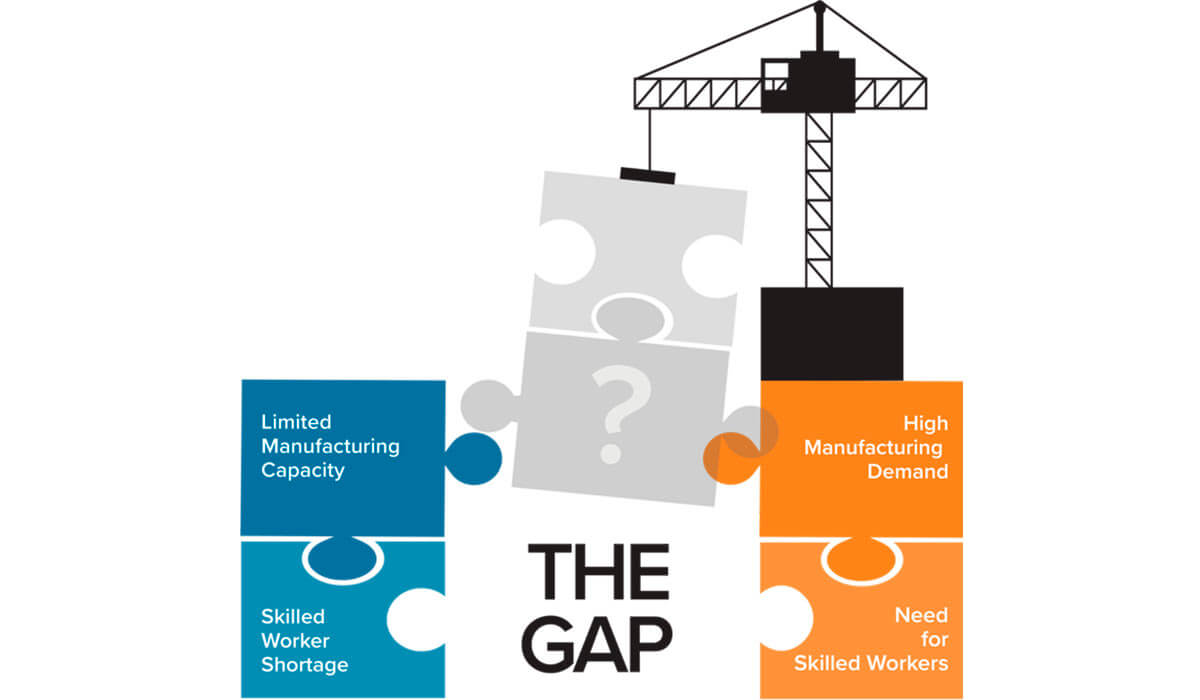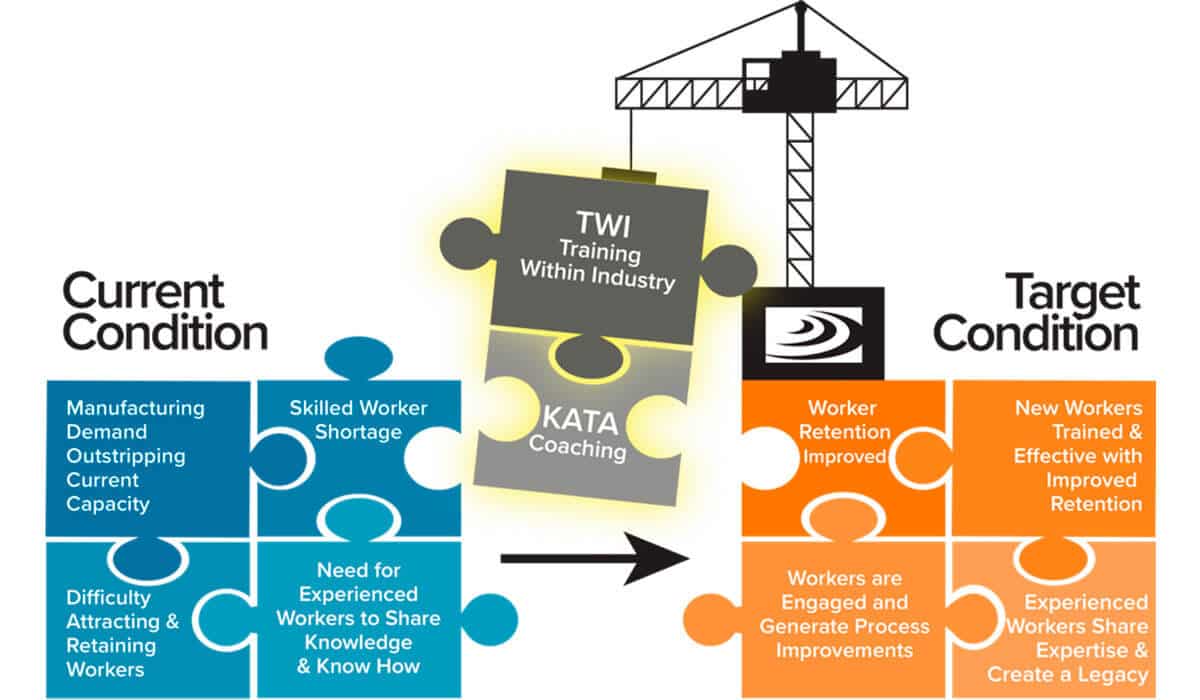

Kevin Pinner presents at PivotPoint: Breakaway Think for Advanced Manufacturing on March 7, 2018 at the Downtown Market in Grand Rapids.
On March 7, I had the pleasure of presenting at PivotPoint, a thought-leadership event designed for the manufacturing and industrial community in southwest Michigan. My topic centered around the biggest challenge facing many manufactures today: how to fill skilled-labor jobs. One solution that delivers proven results is to harness the potential of experience workers using TWI and Kata Coaching. Learn more about the process in this blog.
During World War II, Rosie the Riveter became the iconic symbol of the role women played in the manufacturing ramp-up to support the war effort. “American women entered the workforce in unprecedented numbers during the war, as widespread male enlistment left gaping holes in the industrial labor force. Between 1940 and 1945, the female percentage of the U.S. workforce increased from 27 percent to nearly 37 percent.”1
Although, the need for increasing manufacturing output is not as consequential as supporting armament production during WWII, US manufacturing is currently facing major challenges. Manufacturing demand is high and rising. Many manufacturers are having difficulty keeping up. Compounding this challenge, West Michigan faces a worker shortage. “We are out of workers,” one economist tells West Michigan employers.2 In Allegan and Ottawa counties, the labor shortage is putting a drag on Michigan’s fastest-growing region. See the sobering statistics below.3
+ A lack of needed labor was the main barrier for 72% of those companies
+ 76% of the employers said they had problems recruiting new employees
+ A lack of skilled production workers was cited by 37%
+ A lack of engineers was cited by 28%
+ 13% of the responding companies reported a lack of unskilled labor
To add to this complexity, experienced workers are retiring, and millennials are now the largest proportion of the workforce. There is a significant gap:

How can we bridge the gap and move from our current state to our targeted condition?
One significant benefit of the work that DISHER does in the manufacturing engineering and consulting space is that we are exposed to a variety of companies in a variety of industries. In some cases, automation is a viable solution (although we have seen more than one plant where there is a collaborative robot collecting dust in the corner). Is it possible to harness the potential of experienced workers for the benefit of new workers and address this gap that manufacturers are experiencing? The answer? Yes!
Let’s explore the powerful combination of two well-known and effective approaches to address this gap: Training Within Industry (TWI) and Kata Coaching. TWI (Training Within Industry) was one of the first emergency services established during World War II by the U.S. Government War Production Board in the early 1940’s. A national network of professionals was drafted from industry to develop techniques to quickly ramp-up the production of war materials. It had a major impact on the war effort. Six hundred client companies were monitored by the TWI Service throughout the war.
Results of TWI during WWII
+ 86% increased production by at least 25%
+ 100% reduced training time by 25% or more
+ 88% reduced labor-hours by over 25%
+ 55% reduced scrap by at least 25%
The key to TWI is NOT the tools. The key is the people (the coach, mentor, and learner) and developing a process to coach how to transfer knowledge. It’s about personal development.
TWI is made up of three components:
1. Job Instruction (JI) – Designed to produce effective job instruction to help a person do the work correctly, quickly, and conscientiously
2. Job Methods (JM) – Designed to help team leaders or supervisors develop an improvement plan
3. Job Relations (JR) – Designed to develop team leaders and supervisors
The TWI process uses a simple four-step method for each of the components.
Kata Coaching
Kata Coaching was pioneered by Toyota. It is a structured way to create a culture of continuous learning and improvement at all levels. It deals with an organization’s daily habits or routines forming its “muscle memory” for continuous learning and improvements. The daily habits and routines that are formed to help the organization strive towards a vision through a series of small focused experiments.4
Kata’s roots come from the martial arts. It is a system of individual training exercises for practitioners of karate and other martial arts. Some have called these meta habits. Think of practicing an instrument (playing the scales ahead of time) or practicing driver instruction. Remember how you learned how to parallel park?
How can you take an organization from its current condition to an identified target condition? Kata coaching provides an organization-wide process for harnessing the entire organization in this effort.
Two fundamental components of Kata:
1. The Coaching Kata
2. The Improvement Kata
Many Lean practitioners are familiar with the Improvement Kata through the use of the PDCA (Plan, Do, Check, Act) improvement cycle. The Coaching Kata is what sets this approach apart. The focus is on setting the practice routine and rhythm for teaching the improvement process versus conducting the improvement experiment itself.
The combination of TWI and Kata Coaching creates a powerful approach to developing individuals, team leaders and operators, and for moving an organization towards its target condition. TWI develops the essential skills of: job instruction, method improvement, and leadership. Kata coaching brings an organization-wide process for harnessing the entire organization to move from the current condition to the target condition. Together, we can do it!

DISHER offers TWI and KATA coaching to help manufacturers bridge the gap.
If you are interested in learning more about TWI and Kata, let us know. DISHER would love the opportunity to work with your teams and help them gear-up for a successful future.
Sources:
1Rosie the Riveter – Real Person, Facts & Norman Rockwell – HISTORY
2‘We are out of workers,’ economist tells West Michigan employers – mlive.com
3Labor shortage puts a drag on Michigan’s fastest-growing region – mlive.com
4Toyota Kata – Habits for Continuous Improvements
Written By: Kevin Pinner | Business Lead – Business Solutions | Manufacturing Tech Services
Kevin enjoys improving processes – manufacturing or business processes. When he isn’t doing that, he enjoys playing soccer, running, mountain biking, and driving old sports cars. Kevin has a BS in Industrial Management and MBA in Finance. Kevin leads the DISHER Manufacturing Tech Services and DISHER Business Solutions Teams.
Written By:

Kevin Pinner
Business Lead | Manufacturing Tech
DISHER Newsletter
Sign up to receive articles and insights, delivered monthly.
Schedule a no-committment project call
Reach out to discuss your project to find out if DISHER could be a good fit for you.

